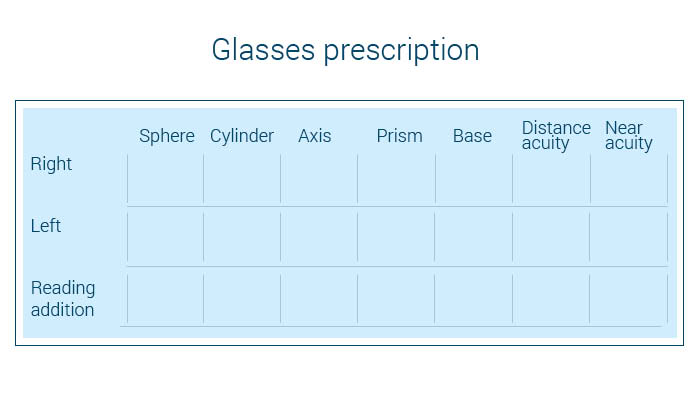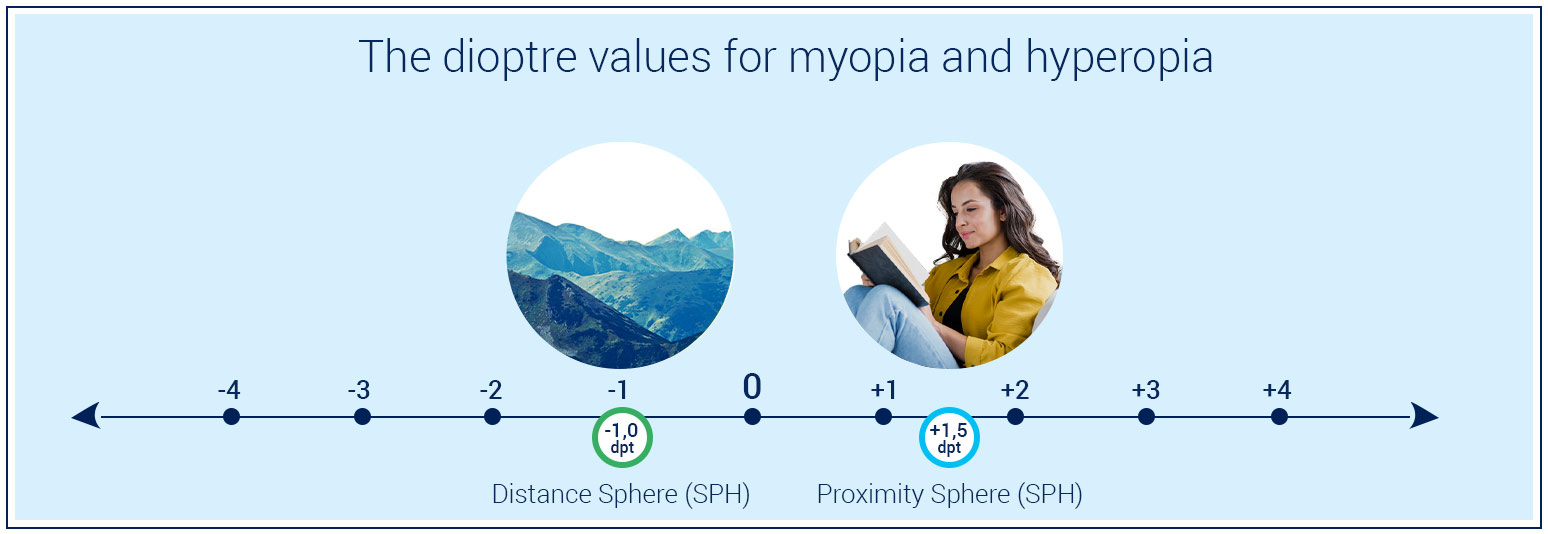How to read a glasses prescription: Learn about OD vs. OS

Table of contents
When it comes to eyewear terminology, OD and OS are two simple yet important abbreviations. You may know they refer to the right eye and left eye, but do you know why?
Looking to have your prescription explained? In this article, Lentiamo optometrist Barbora Keřková defines OD and OS and other common abbreviations found on your eye prescription. Understanding these terms and others will make it easier and faster to get the right glasses and contacts. Follow along to better understand what these terms mean and learn how they relate to your vision!
What do OD and OS mean?
OD, OS
OD means “right eye” and OS means “left eye,” which are shortened from the Latin terms oculus dexter and oculus sinister. OU is another abbreviation you may have seen on your prescription. This comes from the Latin term oculus uterque, meaning “both eyes.” Pretty simple right?
So when you see OD, OS, or OU on your prescription, they simply indicate which eye the correction is intended for.

Understanding an eye prescription
After taking an eye exam, your eye care specialist will be able to determine the appropriate values for different aspects of your prescription. In addition to OD and OS, here are some other common abbreviations you may find useful when understanding your prescription:
Sphere (SPH)
SPH stands for “sphere.” Sphere refers to the amount of lens power needed to correct farsightedness or nearsightedness (or both). It is measured in dioptres in increments of 0.25.
Sphere uses dioptres as a unit of measurement and uses positive symbols (+) for farsightedness and negative symbols (-) for nearsightedness. If one eye requires correction for near vision and the other requires correction for distance, you’ll see both symbols on your prescription.
Cylinder (C, CYL) & Axis
CYL stands for “cylinder.” C or CYL on an eye prescription indicates the amount of lens power required to correct any astigmatism. The larger the number (a number further away from 0.00), the greater the astigmatism correction needed. Similarly to SPH, it’s measured in dioptres in increments of 0.25.
“Axis” is measured in degrees (0 to 180 degrees) and refers to the position the astigmatism is found on the cornea of your eye. Both CYL and Axis parameters are used together for astigmatism.
Addition (ADD)
ADD stands for “addition.” ADD refers to the magnifying power needed for a multifocal or progressive lens prescription, most commonly used to correct presbyopia. It’s always a positive number (+) and measured in increments of 0.25 dioptres.
ADD is usually the same for the right and left eye. In some cases, the addition can be different. Next to ADD you may find the abbreviation D (dominant eye) or N (non-dominant eye).
Prism & Base
“Prism” is used for strabismus (eye alignment issues) or double vision. In glasses, the prism bends light so that it falls correctly on the retina in each eye.
“Base” is the thickest edge of the prism. It indicates where the prism must be positioned to properly redirect light. BI, BO, BU, or BD may be used to indicate whether the base should be “in,” or “out,” or “up,” or “down.”
Distance & near acuity
Distance acuity refers to the ability to see and discern details of objects at a specific distance, often measured using what’s known as a Snellen chart. The results are recorded as a fraction. For instance, 6/12 means a person can see an object clearly at 6 metres what someone with normal vision can see at 12 metres. Distance acuity is also often recorded as decimal. For example, 6/7.5 would be shown as 0.8.
Near acuity is the ability to see and discern details of objects close up, usually measured using reading material held at a standard reading distance.
Both are important for vision assessment and can be affected by various factors, including refractive errors (such as nearsightedness or farsightedness), age-related changes in the eye (such as presbyopia), and eye diseases or conditions.
Pupillary distance (PD)
PD stands for “pupillary distance.” This is simply the distance between the centres of your pupils. It’s measured in millimetres and determines the proper positioning for glasses lenses. It’s quick and easy to measure your pupillary distance yourself if needed!
Plano (PL)
PL stands for “plano,” or lenses without correction. Used for glasses prescriptions, PL just means one eye or lens doesn’t require focussing power for distance or near vision.
Other features of dioptric glasses
For many glasses wearers, your prescription will likely look like the one described above. However, your eye care specialist may add a few special features to ensure the best vision correction tailored to your needs.
- AR coating: Anti-reflective (AR) lens coatings allow more light to pass through your lenses rather than bounce off of them. This bouncing light creates undesirable reflections that make it difficult to see someone’s eyes in photos or online video calls. AR coatings are also designed to reduce eye strain and increase visual acuity.
- UV protection: Added UV protection in your lenses helps prevent your eyes from being damaged by the sun's UV rays.
- Transitions Lenses: Transitions Lenses are equipped with a technology that adjusts the tint of your glasses according to lighting. In the sunshine, your glasses become sunglasses!
- Blue light blocking lenses: These lenses have a unique coating that protects your eyes from artificial light by reflecting blue light that’s emitted from digital devices.
- SV: SV stands for “single vision.” A single vision lens corrects vision for one distance (near or far) within the single lens.
- TF or MTF: TF or MTF stand for “multifocal.” Multifocal lenses encompass more than one prescription within a single lens (for example, both near and distance).
- BF: BF stands for “bifocal.” Bifocal lenses have two separate prescriptions in one lens. One for distance (at the top of the lens) and one for near vision (on the bottom of lens). Oftentimes, you can see a visible line that separates the two.
Other information on a prescription: Your name, date the prescription was issued, prescription expiration date (if any), prescriber’s name, contact number, and signature.
Common contact lens prescription abbreviations
There are some abbreviations on a contact lenses prescription that aren’t present on a glasses prescription. This means your eye care specialist will have to provide a prescription with additional details, such as lens size and curvature, before you can purchase contacts. These measurements ensure a proper fit and clear vision. Lens material recommendations are often added for comfort and safe use as well.
While both contain values needed to correct nearsightedness, farsightedness, and astigmatism (if needed), contact lens prescriptions will also include the following:
BC
BC stands for “base curve,” which indicates how flat or rounded the curvature of the contact lens must be for comfort and stability.
DIA
DIA stands for “diameter” and refers to the width of the contact lens. It’s measured in millimetres.
Did you know? Your eye care specialist may also recommend a specific brand, material, or lens type. This might be in the form of a handwritten note on your prescription.
Is my eye prescription bad?
In general terms, someone with a “bad” or strong prescription needs a higher dioptre correction (for SPH, CYL, or ADD). Those with milder prescriptions generally require a lower correction.
A dioptre measurement of 0.00 means that no correction is needed to see clearly. The farther away a value is from zero, the “stronger” a prescription is. This means that +2.50 is “worse” than +0.50, for example.

In terms of visual acuity, the World Health Organization uses four benchmarks to classify the severity of visual impairment from mild to blindness:
- Mild – visual acuity worse than 6/12 to 6/18
- Moderate – visual acuity worse than 6/18 to 6/60
- Severe – visual acuity worse than 6/60 to 3/60
- Blindness – visual acuity worse than 3/60
While dioptre corrections and visual acuity are important factors in determining the strength of a prescription, they are not the only considerations. Different countries establish specific criteria for legal blindness, which is a designation given to individuals whose visual impairment reaches a certain level.
According to a 2016 study published by the American Academy of Ophthalmology, the number of people affected by myopia (nearsightedness) is projected to increase from 1.4 billion to 5 billion by 2050, affecting about half of the world's population. And those numbers are expected to rise.
How can I buy dioptric glasses online?
Buying glasses online is easier than you might think. At Lentiamo, you can select your favourite frames and add your prescription details in one of three ways:
- Upload prescription
- Enter values manually
- Convert values from contact lens prescription
You can use the virtual mirror feature to see what many glasses look like on you. Just look for the Virtual Try-On symbol on thousands of prescription or sunglasses frames!
Ready to find your perfect pair?
Browse a wide selection of the latest glasses styles from all your favourite brands.
Closing thoughts from Lentiamo
Now that you know OD and OS refer to the right eye and left eye, you can better understand your glasses and contacts prescriptions. We hope this overview of eye terminology and abbreviations has helped teach you how to read your prescription and lets you find your next pair of glasses or contact lenses with ease.
